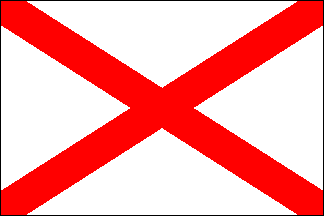St Patrick's Flag

In beginning of the nineteenth century the parliaments of Britain and Ireland were united. However the cross of St Patrick still featured on the arms and flags of various professional and public bodies in Ireland such as the Royal Dublin Society, the Royal College of Physicians in Ireland, Queen’s University in Belfast and the Pharmaceutical Society of Ireland. These bodies were non-political and favoured St Patrick’s cross as a ‘safe’ symbol not associated with any version of Irish nationalism.
In the twentieth century notable users of St Patrick’s cross to represent Ireland include the Irish Rugby Football Union and the Church of Ireland. Both these organisations cover the whole of Ireland and so span its political division. At the end of the twentieth century the Church of Ireland declared that the only flags to be flown on church buildings or within the church grounds were the cross of St Patrick and the flag of the Anglican Communion. When the police force in Northern Ireland was reorganised in 2001 as the Police Service of Northern Ireland it placed the St Patrick’s saltire in the centre of its badge.
On these web pages St Patrick’s cross (shown here) is used on Esperanto pages to indicate that an English version of the page is available elsewhere. English is the most widely spoken language on the island of Ireland
